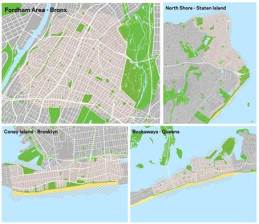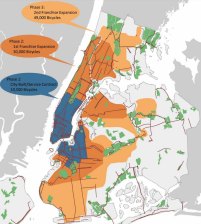It’s Time to Stop Tinkering With Bike-Share and Go Big
Mayor de Blasio can say bike-share is available in all five boroughs, but he still can’t stake a claim to expanding bike-share as a real transportation option.

With the launch of JUMP service in the Bronx earlier this week, Bill de Blasio can finally say bike-share is available in all five boroughs. But he still can’t stake a claim to expanding bike-share as a real transportation option for New Yorkers. The mayor is tinkering with tiny experimental bike-share zones when he should be laying the groundwork for massive bike-share growth.
Nearly a decade after the Department of City Planning envisioned a network of 50,000 bicycles extending far into the Bronx, Queens, and Brooklyn, New York has a system about a quarter of that scale, with most usage concentrated in Manhattan.
In fairness to City Hall, the bike-share field has changed rapidly in the past couple of years. Venture capital has discovered bike-share, Uber and Lyft are now players in the industry, and dockless operations are seen (somewhat warily) as the future, despite a dubious track record in American cities. It’s understandable if the city needed to pause and find its bearings.
But soon there won’t be any excuse to hold back rapid bike-share expansion. By the end of this year, NYC DOT will have gotten a good look at JUMP, Lime, Pace, and dockless Citi Bikes. And with Lyft’s acquisition of trusty but relatively tiny Motivate, the enterprise in charge of Citi Bike will be a well-capitalized operation capable of scaling up dramatically in a short amount of time.
The pieces are in place for a much bigger bike-share network in New York. This system could solve the bike-share shortage in Manhattan, wresting business away from Uber and Lyft cars in the congested heart of NYC (biking is, after all, faster than driving for most rush hour trips in Midtown). And it could expand bike-share access to most of the city — not with Mickey Mouse pilots but with one big contiguous service area offering ubiquitous bicycle availability throughout. Here’s how.
Open up the field
Before Lyft acquired Motivate, it made sense to protect Citi Bike from venture-subsidized competitors that could undermine a successful, established system and then vanish when they failed to achieve lift-off. Now that Motivate has merged with one of the biggest speculative ventures of them all, that logic doesn’t really apply. If other companies can safely and reliably run bike-share fleets, they should get a bite at the apple.
Let’s assume the city does grant long-term status to other companies from its dockless bike-share pilots. These companies should have access to the same territory as Citi Bike, and that territory should be much larger than the current Citi Bike service area.
By the time de Blasio leaves office, he could give New York a bike-share coverage area that looks something like that 2009 vision from the Department of City Planning…
Lyft could veto this arrangement, because the city’s contract with Citi Bike grants exclusivity within its service area through 2029. But the prospect of a large territorial expansion might be enough to sway Lyft (and Citigroup, whose sponsorship underwrites Citi Bike) to trade away exclusivity.
What you want to avoid is a Frankenstein bike-share system with different operators assigned to separate fiefs, where riders have to think about paying two fares to cross boundaries.
Lay out some essential ground rules
A bike-share network this big would dwarf what New York has now, and in the U.S. at least, bike-share operations at such a scale are untested. Dockless bike-share companies in Seattle have struggled to maintain fleets a fraction of this size. New York will want to put in place some enforceable standards, much as it has with Citi Bike, to ensure the companies provide good service and don’t junk up streets with unusable bicycles.
The National Association of City Transportation Officials has laid out some basic ground rules that New York should expect bike-share operators to adhere to, including:
- A mandate for fair bike distribution, so bike-share remains reliably available in low-income neighborhoods within the service area.
- Maintenance standards that guarantee a high share of bicycles on the street, say 90 percent, are in safe, rideable condition and visible in the company’s app.
- Open trip data and anonymized real-time bicycle locations published via the General Bike Share Feed Specification.
Massively expand bike corrals
Even if bike-share doesn’t get any bigger in New York, the city should embark on a program of massive bike corral expansion. Putting bike parking zones in the curb lane by intersections accomplishes a few important goals simultaneously: It makes the intersection safer because bikes don’t block people’s field of vision like cars; it prevents bikes from cluttering sidewalks; and last but not least, it gives people space to park their bikes.

If most of the next wave of bike-share expansion won’t involve docking stations, the imperative to add bike corrals gets stronger. All these new dockless bike-share bikes will need to go somewhere, and just like Citi Bike stations, the best place is the curb lane at street corners. Nominal fees collected from the bike-share companies can pay for these bike parking zones, but they should be open to personal bikes as well.
The trick will be to do it at a scale commensurate with the expansion of bike-share without getting bogged down in tedious spot-by-spot fights at community boards. NYC DOT already managed to do something similar with the Citi Bike station siting process, and City Hall can go big on bike corrals if the mayor doesn’t get squeamish about repurposing parking spots.
Grow the bike network
Bike-share is not an end unto itself so much as one piece in a broader strategy to improve the bike network for everyone. As Dallas is discovering, people won’t even ride bike-share if the streets are terrible for biking.
Right now, DOT is making important upgrades to the bike network with its projects along the Queens Boulevard corridor, and it has a blueprint for safer biking in the Manhattan and Bronx neighborhoods around the Harlem River. But there’s a lot more to be done. In just the past few months, drivers have killed Carlos Vasquez, Aaron Padwee, and Xellea Samonte in separate crashes in western Queens and the South Bronx.
With or without bike-share, City Hall has to make the streets in these neighborhoods safer for bicycling.
Bike-share can help accelerate the process. It generates safety in numbers and grows the constituency for bike lanes. If City Hall goes big on bike-share, it has to ramp up the rest of its bicycle program too.





